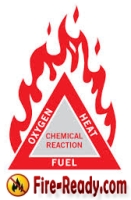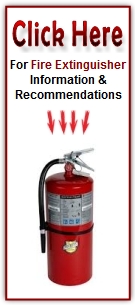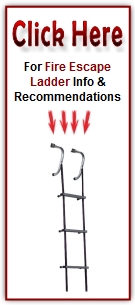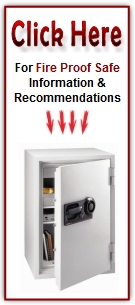
Understanding Fire Extinguisher Types & Uses - A Fire Extinguisher Guide Understanding the types of fire extinguishers and uses is the first step in selecting a proper safety unit for your home, car or workplace. Although there are several different types of fire extinguishers available, each one of them have a particular rating and should only be used on certain classes of fire. After reading this fire extinguisher guide, you should have the knowledge to select the best fire safety extinguisher for your needs.
Before we talk about fire extinguisher types and uses though, it’s important that to understand how fire actually works. One great way to demonstrate this is with the fire triangle. Essentially, there are three elements that must be present for a fire to exist. These elements include Oxygen to sustain combustion, heat to raise the material to its ignition temperature and fuel to support the combustion. When these elements combine it creates a chemical reaction which causes fire. Guide To Fire Extinguishers - How do fire extinguishers work? Different fire extinguisher types are designed to attack one or more elements of a fire to put it out. Since fires have several classifications depending on how they are started and fueled, it’s important to fight each fire using the correct tool. Failure to match the correct extinguisher with the correct classification of fire can lead to minimal results and sometimes even spread the fire further. What are the different types of fire extinguishers and uses?
Water fire extinguishers work by removing the heat element of a fire. These should be used on Class A fires only that involve ordinary combustible materials like wood, paper and most plastics. These should never be used on a Class B or C fire. Class B fires involve flammable liquids like gas and using one of these could spread the flammable liquid. Class C fires involve electrical equipment and we all know that water and electricity don’t mix.
Foam fire extinguishers work by taking away the heat element of a fire and also separating the oxygen from other elements. These can be used on Class A & B fires only and shouldn’t be used on Class C or electrical fires due to shock hazard.
Carbon Dioxide fire extinguishers work by removing the oxygen element of a fire. They also help remove heat due to a very cold discharge. Carbon Dioxide extinguishers should only be used on Class B combustible liquid fires and Class C electrical fires.
Dry chemical fire extinguishers primarily work by interrupting the chemical reaction of a fire. A very versatile fire extinguisher, these are rated to be effective on Class A, B & C fires. Since A, B & C classified fires are the most common, dry chemical fire extinguishers are the most widely used in home fire situations.
Wet chemical fire extinguishers work by first removing the heat element of a fire and then preventing re-ignition by creating a barrier between the oxygen and fuel elements. This type of fire extinguisher was specifically developed for Class K fires that involve cooking oils and fats. Most often these fires occur in commercial restaurants and cafeteria settings.
Clean agent or Halogenated fire extinguishers include both halon and halocarbon agents that work by interrupting the chemical reaction of a fire. Clean agent extinguishers are primarily for Class B combustible liquid fires & Class C electrical fires.
Dry powder fire extinguishers work by separating the fuel from the oxygen of a fire. Dry powder extinguishers are only for use in Class D fires that involve combustible metals like magnesium, titanium, potassium and sodium. What's the best type of fire extinguisher for you? If you are simply looking for a great all around fire extinguisher to keep around your house than you are going to want to get a dry chemical fire extinguisher that is rated for Class A, B & C fires. However, if you have a more specialized situation where a Class D or Class K fire could occur than you are going to want to choose accordingly. In closing, I hope this fire extinguisher guide gives you a better understanding of the type of safety equipment you need. As you can see, the types of fire extinguishers and uses vary depending on the classification of fire danger that is present. |
|
(c) 2018 - Fire-Ready.com
- Subscribe To Our Feed ![]()


 Water Fire Extinguishers
Water Fire Extinguishers Foam Fire Extinguishers
Foam Fire Extinguishers Carbon Dioxide Fire Extinguishers
Carbon Dioxide Fire Extinguishers Dry Chemical Fire Extinguishers
Dry Chemical Fire Extinguishers Wet Chemical Fire Extinguishers
Wet Chemical Fire Extinguishers Clean Agent Fire Extinguishers
Clean Agent Fire Extinguishers Dry Powder Fire Extinguishers
Dry Powder Fire Extinguishers




 Facebook
Facebook Twitter
Twitter Digg
Digg Stumbleupon
Stumbleupon Reddit
Reddit Delicious
Delicious Google Bookmarks
Google Bookmarks Technorati
Technorati Yahoo My Web
Yahoo My Web Livejournal
Livejournal Blogmarks
Blogmarks Spurl
Spurl Fark
Fark Diigo
Diigo Newsvine
Newsvine Slashdot
Slashdot